Written by Kiril Ksenofontov; Originally appeared at Sputnikipogrom, translated by AlexD exclusively for SouthFront
Looking back on it, I might have given Al Capone a few hints.
The best he could do was to operate his racket in three districts.
I operated on three continents. “Major-General, US Marine Corps, Smedley Butler, 1933
The Ukrainian crisis and its subsequent events raised in certain parts of Russian and Ukrainian societies questions on the USA military intervention in the conflict in Eastern Ukraine. Supposedly, the State Department brought, brings and will bring goodwill and progress everywhere, wherever its brave soldiers are. But in reality, is it true?
In this study we decided to look at how things ended in the countries that had the misfortune of experiencing the full force of “militarized democratization” of the USA.
Yugoslavia
The complicated and colourful history of the last European war is not the subject of this article. We can only mention that the Serbs, Albanians, Bosnians and Croats killed enthusiastically each other without the help of the Americans.
From the results of the first bombardments in 1995 (Operation “Deliberate Force”), the Serbs lost many important infrastructures (power stations, water treatment plants and others), which brought a humanitarian catastrophe on the territory of the Bosnian Serbs. Given that the war in Yugoslavia had a semi-partisan character, the majority of those hit by the 338 strikes were somehow connected with civilians. That is, the armed groups of Serbs entrenched on hospital roofs, full of people, from a gunner’s point of view, become military targets. The main outcome of the bombardments resulted in the exodus from Croatian territories of more than 300,000 Serbs, passing under the oversight of the Croatian armed forces and American military advisors. But worse was to come.
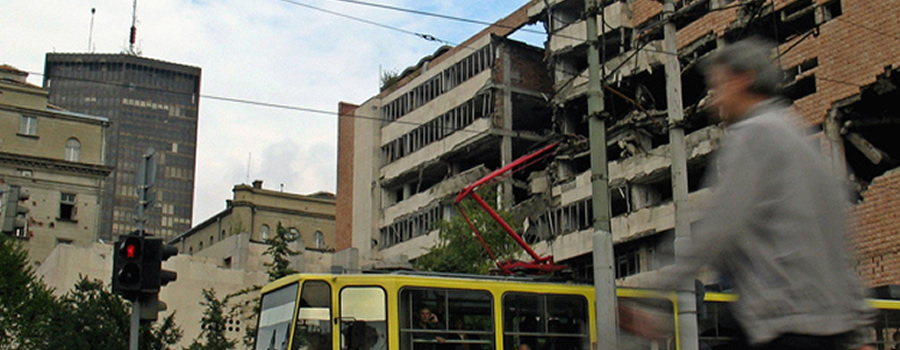
Yugoslav Army Headquarters after the US bombing
In 1999, when the existence of independent Bosnia and Croatia were mostly established, the time came to take care of the liberation of Kosovo and the creation of one more Albania government. In March of that year, NATO countries under the leadership of the USA and without the approval of the UN started a bombing campaign of Yugoslavia, which lasted 78 days. This time they took this matter more seriously: almost a thousand structures suffered the bombardment, a good third of which were civilian structures (hospitals, schools, libraries, residential buildings, monuments). As a result of the bombardments, aside from the military installations, 40,000 houses were destroyed, 300 teaching facilities and 20 hospitals. All in all, the bombing in general was very clumsy: the Chinese embassy came under fire and 3 Chinese citizens were killed. In whole, NATO warplanes killed 2,000 civilians, 88 were children. Two hundred thousand Kosovo Serbs were forced to flee from their homeland. The Americans destroyed 57% of all oil storage tanks, 14 major industries, 9 central electric stations, so yes, a humanitarian catastrophe started in Yugoslavia. The Americans also used depleted uranium, which increased the cancer rate [link here] in Serbia from 1998 to 2001 by 200%.
In courts the Serbs did not achieve anything, they received nothing from the aggressors after turning over their commanders, and now their country is surrounded by a lot of “borderlands”. And practically all these countries today are unhappy in their own way (with very few exceptions).
In 1999 the per capita GDP of Serbia was $4090 and it was around the 56th position in the world. In 2000, the per capita GDP in this country fell to $1161 (96th place in the world). Today the figure stands at $5315, but it still is low (91st place).
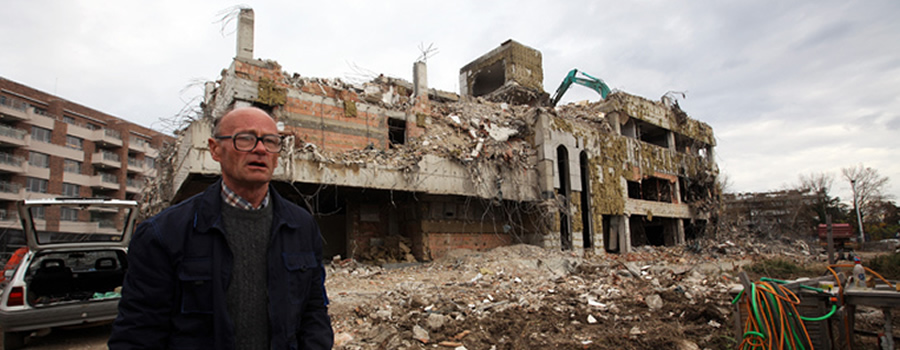
The Chinese embassy in Belgrade after the US bombing
In Bosnia the figures for the per capita GDP were falling in the first half of the 1990s, reaching the critical mark of $563 in 1995 (it is worth remembering that in 1990 the per capita GDP for this region stood at $1713), with the help of the Americans came a “recovery”, it started to slowly grow until it reached $4517 in 2012. Today Bosnia is a poor depressed country.
Montenegro and its friendly residents, favoured by Russian tourists, became quite modest and unpretentious, so appreciated by foreigners, after the spectacular fall in the 1990s, directly tied with the collapse of Yugoslavia: from $3494 per capita in 1990 to $1368 in 1999. After the final break from Serbia, closing the last access to the sea, Montenegro was given the possibility to grow to $7000 per capita.
Croatians got the best deal: regardless of the difficulties of the “divorce” (from $3411 in 1990 to $2688 in 1993), Croatia managed to achieve the most success: $13,105 of GDP today and the “best marriage” (the country recently joined the Eurozone). One must understand that a combination of different factors played a role: Croats are Catholics (this means a lot to European elite), they already had a kindly “patron” (Austria, it also helped Slovenia), for joining, they had to do all sorts of things (privatization, turning over war criminals and so forth). But most importantly, Americans did not play any role in Croatia’s economic growth.
As for Kosovo, for surviving the ups and downs ($624 in 2000), the per capita GDP in one of the youngest countries in the world, today stands at $2813, all of $380 more than in 1990.
To blame the subsequent economic growth on all the above-mentioned countries is not necessary, for example, we can say that the economic growth of South Sudan last year grew an incredible 30% because in 2012 the GDP was 50%. So, in the political arena all the countries of the former Yugoslavia are peripheral colonies of Brussels in different degrees of depression.
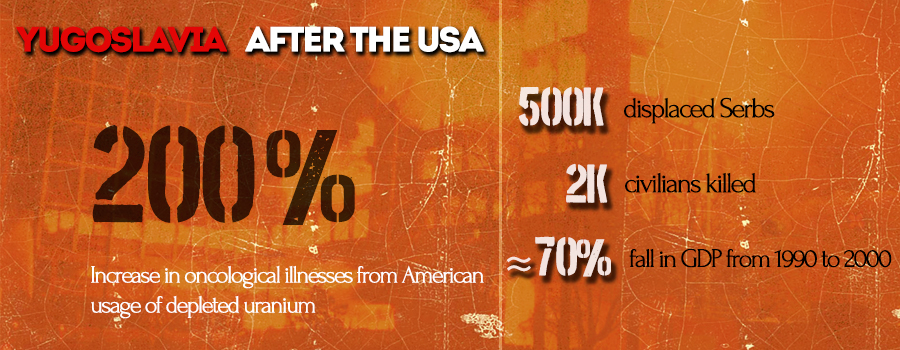
Afghanistan
The most amazing successes of the Americans in Afghanistan brought to the fact that 5 million citizens of that country are in dire need of medical help [link here] and food (which they, of course, do not receive), another 4 million suffer from problems linked directly with this war (ecology, shortage of doctors, and so forth), 650,000 are refugees (that is, they do not even have a dirty village), 2.4 million citizens left the country after the American invasion. The army and police find themselves in a constant war with all the country; during the American occupation, some 13,000 of them were killed [link here]. In the course of these 13 years as a result of military actions more than 20,000 civilians were killed [link here].

Photo: Associated Press
The country did not bless the world with any good news, but the American invasion brought into this nightmare a sweet taste of narcotic delirium: from 2001 the opium production in Afghanistan grew 40 times! The raw narcotics are produced in 19 of the 34 provinces of the country. Last year Afghan shock workers of the democratic economy gifted humanity with 6,062 thousand tons of opium, 36% more than the year before. This way, during the American occupation, the country increased its share in the world production of heroine by 75%. The results for this year that are expected is that the Afghan workers will grow even more opium and will increase this figure to 90% of heroine in the world.
The NATO bureaucrats with angry disgust look at the flowering of drug crime and fight it with all their strength… but no, on the contrary: they refuse [link here] the destruction of the poppy fields because “it would deprive work and revenue to a significant part of the country”. Even if the country has already 1.5 million drug addicts, for 400,000 people coming into the labour market each year, the poppy fields present a great opportunity for employment, in contrast to the more clean and ethical farming practices: if all surfaces on which poppies are cultivated were planted with wheat, only 20% of people would be able to work from the number of people that work now. The poppy fields give work to 200,000 large Afghan families; this is 73 million working hours in a year and 15% of the GDP, a colossal industry. The price for raw opium varies between $80 and $300. The Americans are preoccupied with the imminent “demobilization” and the withdrawal of the troops from the country, so the effectiveness of the efforts of the war with the drug mafia in 2013 was 24% lower than the previous year.
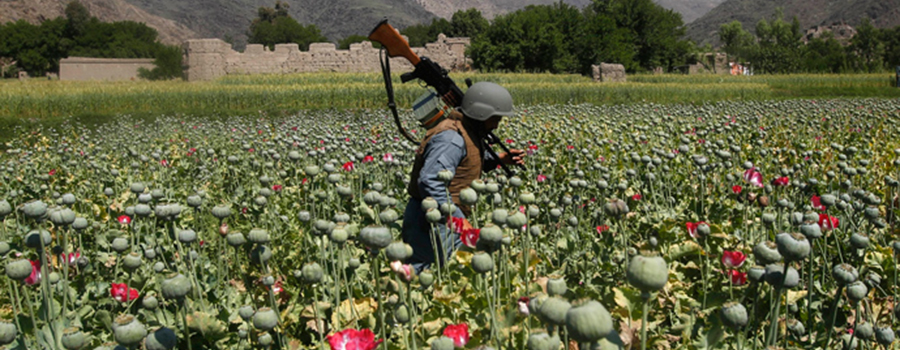
An Afghan policeman destroys poppies during a campaign against narcotics in Kunar province, April 29, 2014 (Reuters / Parwiz) / Reuters
Ah yes, Afghanistan is among the three most corrupt countries in the world. Of course we should not draw any attention to the fact that for the recovery of Afghanistan, the Americans invested $102 billion with stunningly bad results [link here]. For sure the American military and officials are not linked to corruption in that country, even the word “cut” they do not understand. However the word “graft” is fully understood. It looks like all this is of course extremely idiotic: the American taxpayers paid the Taliban $360 million only for transportation contracts. The surprised reaction by the Pentagon always impresses: “Comrade Stalin knew nothing of the enemies in the Central Committee”.
That Afghanistan surprisingly was in an even worse position than before the invasion, I will stay silent: after the departure of the troops, the country is expecting a new round of bloodletting in a civil war. The central government controls Kabul with difficulty, the rest of the country represents itself as the “heart of darkness”, full of pain, violence, despair and religious fanatism.

Iraq
If we paraphrase a well-known American song, then ”Saddam fought with the State Department, but the State Department won”. However the Ba’athist dictator proved to be entrenched and tenacious, to get rid of him two wars and 12 years of embargoes were needed. The military campaign is very well covered in several books, but we will look at the aftermath of the American invasion for this country.
It is believed that the first round in 1991 took the lives of more than 3,600 Iraqi civilians [link here]. But his is just the tip of the iceberg.
In the 1991 war the Americans again used almost 300 tons of depleted uranium and the long-term effects of its use did not slow down its impact in the ensuing decades. Do not forget about the destruction of major infrastructures: the country was subjected to total bombings and in fact was sent to the Stone Age. Water supply, electricity, gas – people take it for granted but without them their lives are more difficult and shorter. Post-war problems in healthcare cost Iraq incredible losses – 111,000 people [link here]. If we add the Kurdish and Shi’ites uprisings encouraged by the Americans after the war, then do not forget another 35,000 killed in the course of their suppressions.
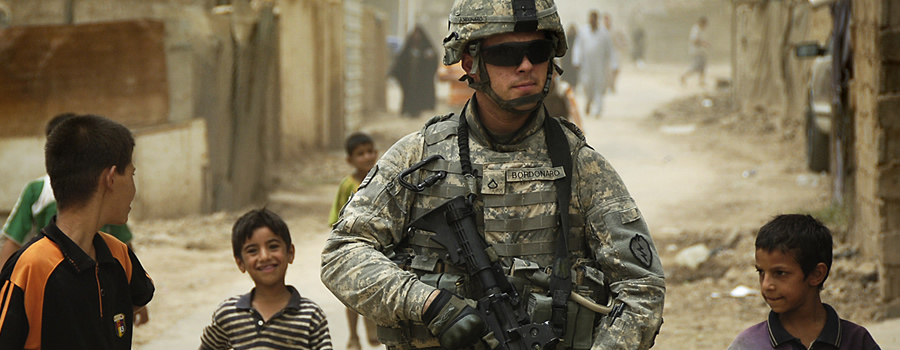
Buy one democracy, get one free!
Wars, however for the American seemed not enough. The following 12 years Iraq spent them under heavy sanctions, reminding us of Iran. Their effects were monstrous [link here]: per capita GDP fell from $3510 (1989) to $459 (1996); the majority of Iraqi households spent 75% of their revenue during the blockade years on food; 60% of Iraqis depended on government rations (which only supplied 40% of the daily ration); a decade of malnutrition killed 576,000 Iraqi children [link here]; childbirth mortality in the south of the country rose from 47 deaths for every live 1000 births (1989) to 107 deaths for every live 1000 births (1999); death among children below 5 years grew from 56 to every 1000 children (1989) to 131 for every 1000 children (1999); a quarter of children stopped going to school, half suffered from diarrhea and fever; the high level of literacy among women (87% in 1985) fell to 70% (2013); maternal mortality rose from 117 deaths for every 100,000 women to 294 death for every 100,000 women in the last 10 years.
When the second war began in 2003 (again without the approval of the UN), it seemed that it could not get worse. “But there are no such fortresses that the Americans cannot take”: a minimum of 116,000 civilians were killed [link here] in the resulting military actions, that the Americans carried out or their allies, another 655,000 people died [link here] from complications caused by the war, 2.8 million residents of the country became refugees. In the country today, there are 5 million children that are orphans so that, thanks to the USA, Iraq will soon have a whole generation that does not remember normal life. Cherry on the cake: the majority of sanctions imposed on Saddam’s Iraq were lifted only in 2010 by the Americans [link here].

Iraqi women walk down a busy market street in eastern Baghdad, Iraq, June 21
The situation of women’s rights in Iraq remains extremely tense. In the first months, after the dissolution of the army and the Ba’ath party by the Americans, a wave of kidnappings and rapes of women swept the country, because the security forces were paralyzed after the wonderful American management reforms. In the first seven years after the American invasion 4,000 women were abducted [link here] with the intent of selling them as sex slaves and 20% of them were under 18 years old. The events in the last twenty years left in the country 2 million widows [link here] and in the rapidly Islamisation of Iraq they became one of the most vulnerable groups of the population. Already in 2011 “Human Rights Watch” [link here] mentioned that the situation in the country became worse for women (as well as journalists and detainees), in 2013 the same organisation stated [link here] that the torture and rape of women detainees are commonplace in that country. Strictly speaking, it is the Americans that gave power to the Islamists and their sympathizers with the abolition of the Ba’ath party, which was not ideal but at least made the emancipation and protection of women possible in Iraq more than anybody else.
Americans also defend their soldiers in an “exemplary” fashion in any situation: the history of the private military company “Blackwater” you already know, how the head of the occupation headquarters in Iraq Paul Bremmer freed from legal liability all American mercenaries in that country, which permitted them to kill with impunity Iraqi citizens. The political leadership of the USA took the same approach with the regular army: Sargent Frank Wuterich killed 24 Iraqi civilians, for which he received a fine and a reduction in rank. There was also a 3-month prison sentence but he was released right from the courtroom, so that these details are not important anymore.

Sargent Frank Wuterich
Although in the last 11 years, the Americans kept on their payroll and bayonets the current corrupt regime of Nouri al-Maliki, however, despite all the efforts of the State Department, its disintegration in front of our eyes.

Libya
The “case” with this country is very good because the Americans and NATO limited themselves to mostly air strikes and sending Special Forces instructors. This is what may also happen on the Ukraine. It was not expensive: at the end of August, the Americans spent [link here] on the support of the revolutionaries and war a bit less than $1 billion. After the NATO air raids, 60 Libyan nationals were killed and 55 were injured. But, surely, the efforts for democratisation were worth it?
In fact we need to be aware that Gaddafi was never an enemy of the West. He was a friend of the political leadership of Italy, France, England and even the USA (he turned over to the CIA numerous Islamists), allowed Western corporations to pump oil. He had his faults (provided shelter for the IRA and the ETA), but, in all fairness, he was not worse than any other monarch in the Gulf. Even better, in the end, in his Libya there was no Sharia Law. In general there were no dangers in the country, the well-known actor Ewan McGregor comfortably rode through on his motorcycle [link here]. Although the great leader stole a huge amount of money, for the people he built a good welfare state and in general brought the country of Bedouins and sand dunes to the high living standards of the first world, giving a per capital GDP of $14,192. However the revolution and war, organised with specific separate tribes and part of the elite, brought down the figure to the $6000 level, so far this year it stopped at the $9000 level. According to the results before the seizure of power in the country, 30,000 people were killed [link here].
But what about security? But with security all is very bad [link here], in fact, the war did not finish: Libya is divided between armed groups of different sizes and degree of madness. These groups constantly clash, blockade oil production facilities, kidnap officials and foreign diplomats – in one word, the country is run like a pirate ship with a distinctly jihadist flavour. Local liberals and hipsters if there were any, do not manifest themselves in political life – the Islamists control everything, they hold the real power. After the revolution the number of murders increased by 503%; robbery, by 483%. Eight thousand people sit in jails without charge.
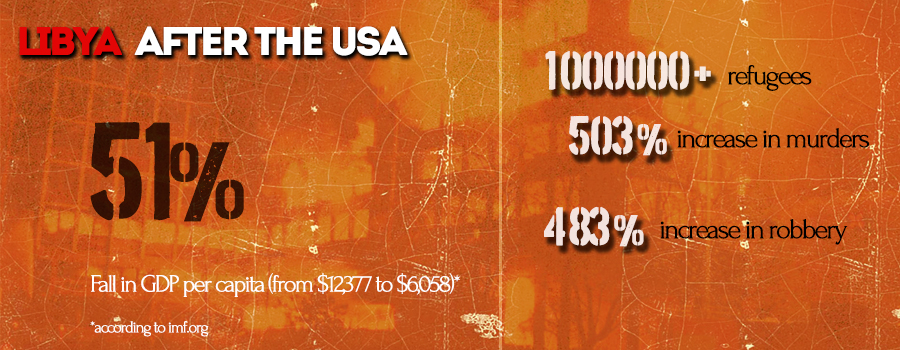
In May, returning from exile, General Khalifa Haftar carried out a “secular counteroffensive”, but it is understood that in case of victory it would, to put it mildly, not be in line with a fully democratic leadership. His hands up to his elbows are already full of blood and, most of all in case of a victory he would install a military dictatorship, taking example from his Egyptian friends and colleagues. It goes without saying that it would be a better version of tribalist Sharia Law, but was it worth changing a “legitimate” satisfied Libya of Khadafy to a hungry dictatorship of Haftar?
As it becomes clear from the cursory review of American moves, democracies in countries “cleaned” by them do not flourish, but chaos and suffering increase manifold, making further democratic developments impossible. History experts can point to Japan, Taiwan and South Korea, but in these countries with military protection everything was delimited: internal affairs of these countries were decided independently, going even sometimes against American recommendations. Still, even after all the horrors, described above, I consider it important to bring to our readers the following.
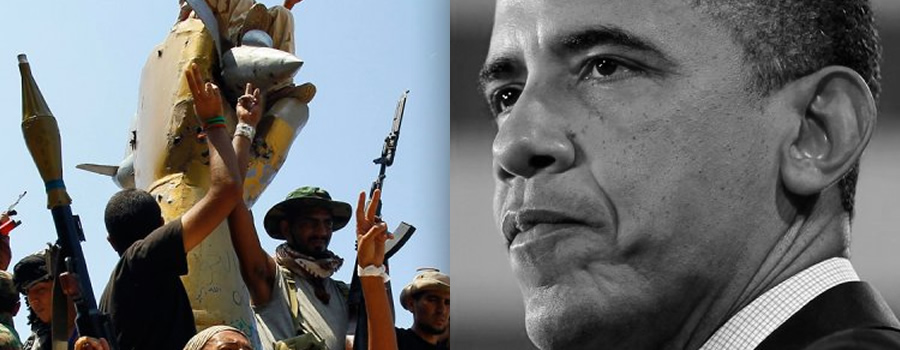
Viva Obama! Viva Jihad!
Blaming Americans of “double standards”, “mendacity”, “hypocrisy” and “arrogance” is like scolding a dog for being a dog. Even this is, of course, a high level indicator of geopolitical of victimization in the minds of the Russian Federation citizens: “Well, of course he promised, kissed, shook hands, a non-aggression pact…” Americans cynically and businesslike make their decisions disregarding the rest of the world, all grown-up nations do so. Russians, instead of outrage, should, on the contrary, learn from the Americans. Another question, how the stronger the actions of the “majoritarian nations” end for “minoritarian”. Well, nothing left except to say “Vae victis!” [Translator’s note: Woe to the defeated]
P.S.: since we look at processes, the timeframe is long, the data on per capita GDP of Yugoslavia and Iraq are based on the dollar rate of 1990.

